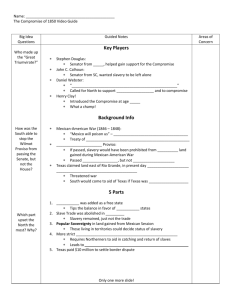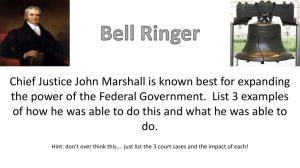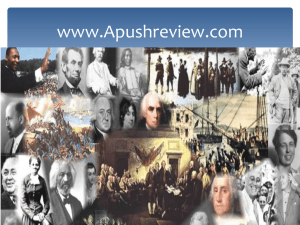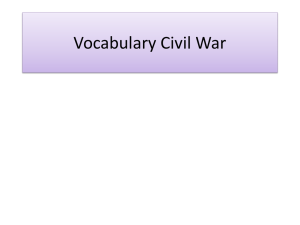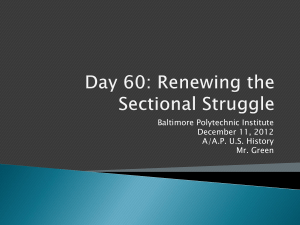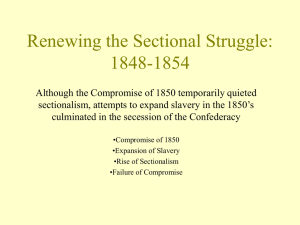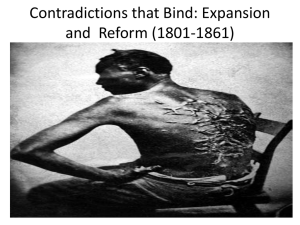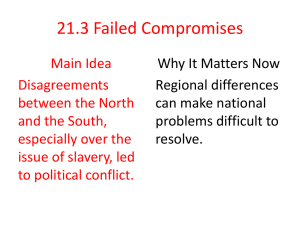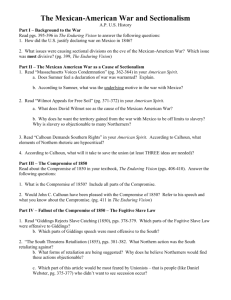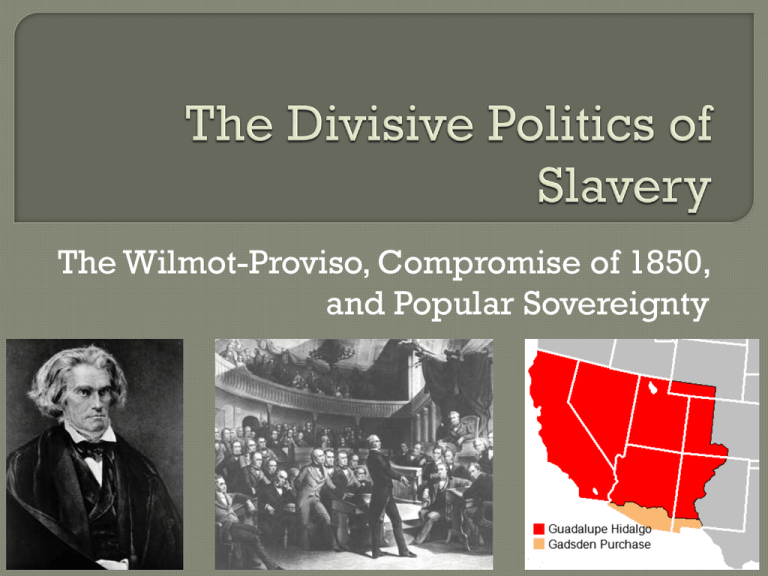
The Wilmot-Proviso, Compromise of 1850,
and Popular Sovereignty
To
understand how the Wilmot-Proviso
was viewed by the South, and why it
failed.
To
explain how the Compromise of 1850
came to be formed, who was involved,
and the implications of this act.
Key Terms: Wilmot-Proviso, Compromise
of 1850, and Popular Sovereignty
In the North, industrialization shaped the growth of cities and Northern
railroads helped rapidly expand the nation westward. Telegraph wires
were strung along the 20,000 miles of tracks and allowed for fast
communication.
The population in the
North was diverse
due to the large
portion of immigrants
who worked in the
factories.
How did immigrants
effect the political
opinion towards
slavery in the North?
The South remained rural and consisted of plantations and small farms. The
South had 1/3rd of the nations population and produced less than 10% of the
nations manufactured goods. Immigrants did not settle in the South, and many
Southern states had populations with African-Americans in the majority.
After the Treaty of Guadalupe
Hidalgo, large areas of land were
ceded to the U.S. , most of which were
below the Missouri Compromise line.
In 1846, Democrat David Wilmot
from PA introduced a military
appropriations bill that claimed
that no state acquired through war
could have slavery.
What was the nations reaction to this bill, and why did they react in various
ways?
Northerners agreed with the proviso for
two reasons: (1) They were angry about
the Southern congressmen who did not
vote for internal improvements. (2) They
feared the expansion of slave states.
Southerners argued that the proviso
violated their constitutional rights to
property, since slaves were property.
The House of Representatives
passed the proviso, but the
Senate rejected it. Many saw
this conflict as a sign of darker
times to come.
1850: Propaganda
criticizing the
tendencies of certain
individuals to place
regional concerns
above the Union as a
whole. From left to
right, David Wilmot,
author of the Wilmot
Proviso, abolitionist
William Lloyd
Garrison (1805 1879), former vice
president John
Caldwell Calhoun
(1782 - 1850) and
newspaper editor
Howard Greeley (1811
- 1872) heap their
various issues into
the 'hurly-burly pot',
while military traitor
Benedict Arnold (1741
- 1801) reaches out of
the flames
The gold rush led to many of the
territorial phases being skipped in
applying for statehood, and
California applied for statehood in
1849.
A problem arose when California’s
constitution forbade slavery.
Southerners assumed that CA and
other territories below the 36°30’
would be open to slavery.
The president, Zachery Taylor, supported CA being admitted as a free
state, as well as arguing that the South could counter abolitionism through
allowing the individual territories decide on the matter of slavery.
When the 31st
Congress met, the
issue of CA
statehood was at
the top of their
agenda.
Other issues of
slavery also came
up with TX and DC,
and Southerners
began viewing
secession as the
only means to an
end.
Clays compromise had several terms:
1) California is admitted as a free
state.
2) Utah & New Mexico territories
decide about slavery.
3) Texas-New Mexico boundary
dispute resolved with $10 million
payment to TX from the federal gov’t.
4) The sale of slaves is banned in D.C.,
but slavery would remain legal there.
5) Fugitive Slave Act required people
in free states to help capture and
return escaped slaves.
Clay worked hard to find a balance
that would appease both the North
and South.
The
North was appeased with the addition
of California as a free state.
The
South was appeased with the new and
more effective Fugitive Slave Act.
Popular
Sovereignty, or the right of a state to
choose whether it is free or slave, appealed
to both the North and South.
Clay
pushed this compromise because he
feared the only other option would be
disunion or even war.
JOHN C. CALHOUN
Believed strongly in state’s
rights over federal power.
Held the interests of
southern slaveholders as a
high priority.
Thought Northern
abolitionist fueled the
sectional issues, and the
South had no choice but to
secede.
DANIEL WEBSTER
Did not believe that slavery
should extend into the
territories.
Placed national interests
over those of his own, or
that of a region, as seen in
his response to Calhoun’s
threat of secession.
Although Clay seemed to have all the right ingredients for a good
compromise, it was rejected and Clay left Washington discouraged.
This was not the end of the compromise though, and
Stephen A. Douglas, a senator from Illinois took on
the job of passing this essential plan.
What ingenious plan did Douglas use to pass the
Compromise of 1850 through Congress?
Douglas passed each measure of the compromise by
introducing them individually rather than as a
bundle.
Also, the death of both Calhoun and President Taylor
took two opponents of the compromise out of the
picture.
HW: Read
excerpt from “Uncle Tom’s
Cabin”
Be
prepared to discuss the reading and
maybe even have a quiz.
Push
in your chairs and leave the room
better than you found it! Have a great
day

